Stop the Spike – Blood Glucose Control as a Longevity Strategy
Acarbose is incredibly effective, but my self-experiments found a simple supplement combination that might work even better.
From the dozens of life-extending interventions discovered in humans and animal models, one mechanism shows up again and again: moderation of blood glucose levels.
To understand why, we first need a quick primer on how the body handles glucose.
After a typical meal, enzymes in the gut called amylases and glucosidases break starches and other carbohydrates down into individual glucose molecules. This glucose then enters the bloodstream for distribution to cells throughout the body (see illustration below).
The pancreas senses the rise in blood glucose, and releases insulin to signal to other tissues that it’s time to make use of this glucose. The liver and muscles (the two biggest glucose sinks in the body) respond by taking up glucose and either using it for energy, or turning it into glycogen, a starch-like storage molecule that can be used for energy later on when food-derived glucose is scarce. The insulin signal also tells the liver to stop making and exporting its own glucose, something it does between meals to keep a steady supply of glucose available for the brain and body .
If this system works properly, glucose levels are held continuously in a narrow range, from about 70 to 140 mg/dL. But when insulin is overused, cells stop responding to it appropriately, requiring more and more signal to achieve the intended effect. This happens when carbohydrate intake is excessive, when exercise isn’t sufficient to help with clearance, or when there aren’t enough “reset” periods without glucose. That’s insulin resistance.
As we age, insulin resistance is usually one of the first issues to surface, resulting in fasting glucose elevations and impaired glucose control after meals. Left unchecked, this is terrible for health and longevity.
Poorly controlled glucose spikes cause:
Increased production of reactive oxygen species (ROS) from the flood of fuel entering the mitochondrial respiratory chain. These ROS damage proteins, DNA, and lipids.
Generation of Advanced Glycation End‑products (AGEs) when excess glucose permanently attaches itself to other molecules, changing their shape and impairing their function.
Increased inflammation. ROS and AGEs both activate inflammatory pathways, driving up things like TNF- α, IL-6, and CRP.
Transformation of cells into a senescent (nonfunctional) state in response to elevated inflammation and oxidative stress.
Collectively, these changes further impair the ability of the liver and muscle to respond to insulin, driving greater insulin resistance. For a while, the pancreas compensates by releasing more insulin, but eventually it exhausts itself, resulting in type 2 diabetes.
But even if things don’t reach that critical breaking point, chronically elevated glucose is prematurely aging cells and tissues throughout the body. This is a major reason why a healthy diet and regular exercise are so critical for aging well.
Unfortunately, this problem is incredibly widespread. Metabolic dysfunction now impacts 9 in 10 adults, with rates only continuing to rise.
Interventions for glucose control
As you might expect, lifestyle interventions are highly effective here. Eating fewer carbohydrates, exercising regularly, and increasing time spent in the unfed state can all work wonders for restoring insulin sensitivity. But sometimes, we can benefit from a little extra help.
And thankfully, modern medicine has given us dozens of tools that can do just that. Metformin slows glucose uptake in the gut, while also decreasing glucose output from the liver. SGLT2 cause excess glucose to “leak” from the blood into the urine. And acarbose inhibits starch-degrading enzymes in the gut to slow the rise in glucose after eating.
It's no coincidence that all of these can also extend lifespan in mice. Simply adding these drugs to a mouse’s food, without making any other changes, results in median lifespan increases of 6% for metformin, 14% for canagliflozin (males only), and 17% for acarbose. When acarbose is combined with rapamycin, another potent lifespan extender, mice live an average of 34% longer, making this the most potent intervention ever discovered for lifespan extension in mammals. And the benefits aren’t only on lifespan. In each case, the mice remain healthier for longer, with fewer age-related complications and better function late in life.
As an example, take a look at the dramatic effects of acarbose treatment beginning at four months of age in mice. Simply adding this drug to their food causes large reductions in the subsequent rate of lung tumors and in age-related changes in the adrenal glands (adrenal medullary vasodilation), liver, and kidneys (glomerulosclerosis). Reducing glucose spikes seemingly helps nearly every organ in the body.
Given these amazing results, I’m always surprised that acarbose doesn’t receive more attention in longevity discussions. It is cheap, widely available, has an excellent safety profile, and comes with clear well established human dosing guidelines. It checks nearly every box for a longevity intervention that is ready for widespread adoption right now.
The Power of Acarbose
Acarbose is a natural compound, first identified as a metabolite produced by soil bacteria. It is a pseudotetrasaccharide, meaning that it is structurally very similar to a chain of four sugar units. But since two of the individual sugar units are different from those that exist in plants and animals, human enzymes can’t quite process it.
This means that it can’t be degraded by glucosidases and amylases in the gut. The enzymes recognize it as a polysaccharide and try to break it down, but the unusual structure prevents the reaction from taking place. Instead, the molecule sits in the active site of the enzyme, inhibiting it and preventing it from breaking down actual starches in food.
This is exactly how the drug exerts its beneficial effects. Starch digestion slows dramatically, moderating the post-meal rise in blood glucose. Lower glucose peaks are much easier for the body to handle, leading to less insulin release and fewer detrimental effects from high glucose levels. Over time, this can help lead the body towards a more insulin sensitive state. In type 2 diabetics, it can be used effectively as part of a glucose control strategy alongside other medications. Hence, the drug approval and commercialization for that purpose.
I wanted to see just how effective acarbose is for my personal physiology. I’m currently very insulin sensitive, but I still use acarbose to keep my healthy glucose levels even lower (the lower end of the healthy range is associated with positive health outcomes such as a reduced risk of future dementia).
For this experiment, I wore a continuous glucose monitor (CGM) to follow my blood glucose levels in real time. Starting in the morning after an overnight fast, I consumed 50g of carbohydrate in the form of white bread, similar to the control condition that is used to determine the glycemic index of different foods. I then monitored glucose changes for two hours after the meal. For each of the graphs below, I normalized the starting glucose to my daily average of 92 mg/dL to make the data easier to visually digest.
In the control condition, where I consumed the bread without any drugs or supplements, my blood sugar levels quickly rose to a sharp peak of about 150 mg/dL at 30 minutes, before quickly returning to baseline at about 50 minutes. This reflects the incredible efficiency of the starch degrading enzymes in my gut, which quickly turned the bread into glucose. Even though my body quickly brought the levels back to baseline (demonstrating good insulin sensitivity) I still spent fair amount of time in a glucose peak, and even a few minutes above the upper healthy threshold of 140 mg/dL.
With acarbose, things look much, much different. There is really no peak to speak of. Instead, there is a small bump from about 40-70 minutes, followed by a gradual rise. Since my intestinal glucosidases and amylases were inhibited, the starch moved through my upper GI tract largely intact. Surely, some starch was being degraded into glucose, but the levels were low enough that they were quickly taken up by tissues, with no evident spike.
Since levels were kept low, there was likely very little generation of ROS, very little glycation, and very little downstream inflammation. Furthermore, most of this sugar was likely taken up by the liver and muscles rather than spilling over into fat cells. This is exactly what we want.
Acarbose Alternatives
I’ve been painting a pretty rosy picture for acarbose. It works extremely well, costs less than 50 cents per meal, and has very few side effects. In my case, I don’t even really notice I’m taking it, unless I’m wearing a CGM.
But there is one small problem—the acarbose farts.
Since so much starch is sent into the lower GI tract without being digested, this provides a rich prebiotic feast for bacteria in the colon. They have their own digestive enzymes that aren’t inhibited by acarbose, and they happily go to work fermenting the starch, producing gas as a byproduct.
Additionally, acarbose itself is toxic to certain gut bacteria, killing some species while encouraging the growth of others. Collectively, this actually causes some very positive shifts in the gut microbiome, but for some people, it can also cause very bad gas.
Not just farts, but painful, debilitating gas.
I used to joke that we should put acarbose in the drinking water as a public health measure. But when I convinced my wife to try it, I’m pretty sure she wanted to kill me. She was doubled over with painful gas for the next five or so hours, and swears she will never again take this white devil pill. Don’t say you haven’t been warned.
One more issue—acarbose is a prescription drug, which is a significant barrier for a lot of would-be users. Yes, it can be easily obtained from telemedicine providers (which I absolutely recommend), but the prescription requirement is still an extra hurdle.
Given these issues, I wondered— could there be an over-the-counter alternative that works just as well, without the gas? Dozens of glucosidase and amylase inhibitors have been reported in the literature, and many of them are available in pill form as supplements.
So, I ran a series of tests. I tried seven different compounds, each at the doses recommended either on the bottle or in published studies, with some very interesting results.
Here’s what I tested:
Acarbose
The benchmark compound. Strong clinical support for moderation of glucose peaks. Dose: 50 mg.
White Kidney Bean Extract
This protein extract of the common bean (the kind you eat) inhibits amylase, the enzyme that breaks starches down into smaller polysaccharides that are subsequently handled by glucosidases. Several commercial preparations are available and these have been shown clinically to reduce post-meal glucose spikes. Dose: 650 mg.
Epigallocatechin-3-gallate (EGCG)
A powerful antioxidant derived from green tea that has also been reported to inhibit glucosidases and amylases. EGCG exhibits a wide range of biological activities—some desirable, others potentially not—making it a less-than-selective compound. Dose: 800 mg.
Grapeseed Extract
An extract produced from byproducts of wine production that contains high levels (~95%) of proanthocyanidins, which inhibit glucosidases and amylases. This one also exhibits the very desirable side effect of improving arterial health at the same doses used for glucose control—a nice bonus. Dose: 400 and 800 mg.
Salacia Reticulata
A plant that is widely used in Ayurvedic medicine as an antidiabetic agent, Salacia contains sugar mimicking compounds called thiosugars, which have potent inhibitory activities against glucosidases and amylases. Dose: 3g.
Allulose
A natural sugar found in low levels in various dried fruits and syrups, allulose is also a weak inhibitor of amylases and glucosidases. In addition to effects on starch breakdown, allulose also inhibits gut transporters responsible for glucose uptake, giving it multifaceted action for blunting glucose spikes. Dose: 1 and 5 g.
White Mulberry Leaf Extract
A natural source of the potent glucosidase and amylase inhibitor 1-deoxynojirymycin (DNJ). Unfortunately, DNJ is also absorbed by the gut and distributed throughout the body, where it can have off-target inhibitory effects on lysosomal enzymes—a potential concern for cellular health. For this reason, it isn’t something that I’d want to take long-term. Dose: 1 g.
Cinnamon
A classic herbal remedy for diabetes. In addition to its reported positive impacts on body-wide insulin sensitivity, cinnamon also exhibits inhibitory activity against glucosidases and amylases. Dose: 600 mg.
The Experiment
To my surprise, everything worked to varying extents. Each of the supplements reduced the height of the glucose peak, from about 25% for Salacia to about 75% for 5g allulose. In fact, 5g allulose worked even better than acarbose, although it produced terrible side effects.
A couple of hours after eating the bread, I started to feel a painful gas sensation building in my abdomen. By lunch time, I had to leave work early and head home. It was horribly uncomfortable.
Given this less-than-desirable experience, I thought I would see if a lower dose might blunt the peak to a similar extent without the gas. At 1g, allulose still worked, albeit to a lesser extent, but it still caused a lot of discomfort. After that, I was done with allulose.
The other top performers each had their own issues. White mulberry leaf worked well, but as noted above, I’m not too enthusiastic about ingesting something that will also inhibit lysosomal enzymes that our cells use to recycle wastes. Cinnamon worked well enough, but the lower dose actually outperformed the higher one, suggesting that it might yield variable results. Finally, 800mg grapeseed extract worked very well, but this is a rather high dose for this compound—probably more than I would want to take two or three times a day.
But several of these compounds still showed real promise. And because they potentially act through different mechanisms, I wondered whether they might work even better in combination.
For example, white kidney bean extract is believed to be an active site inhibitor of amylases and glucosidases, meaning that it mimics starchy substrates and fits into the same starch-binding pocket on the surface of the enzyme. The proanthocyanidins in grapeseed extract, on the other hand, look nothing like starch, and are thus more likely to be “allosteric” inhibitors that bind to a different site on the enzyme. The same is true for cinnamon.
Given these different modes of action, they could have additive or even synergistic effects when used in combination. By inhibiting the active site of the enzyme and multiple allosteric sites, they could essentially coat the starch-degrading enzymes with inhibitors, more effectively shutting down starch degradation and leading to a greater reduction in the glucose peak.
I tested this combo, and that’s exactly what happened.
Each supplement alone produced a modest reduction in the glucose peak. But when combined, their effect was dramatically amplified, almost completely eliminating the spike.
When you look at the full glucose curves, the benefit is clear. But it’s even more striking when you isolate the peak values; the combination flattened the post-meal spike far more effectively than any single supplement.
Naturally, I was thrilled with these results. Here was a simple, cheap supplement stack that worked even better than a prescription drug for blunting glucose spikes after a carb-heavy meal. Used regularly, this could have very positive benefits for glucose control, with all of the expected downstream benefits on insulin sensitivity, healthspan, and longevity.
Even better, there were zero side effects. No gas, no bloating, no discomfort at all.
I was so excited, in fact, that I even decided to risk the very success of my marriage by asking my wife to try it. And, guess what? It passed the wife test with flying colors. No issues, whatsoever.
Practical Application
I’d encourage anyone who is interested to give these strategies a try. Even if you’ve dialed in your diet and exercise to encourage a healthy state of insulin sensitivity, you might benefit from using a glucosidase inhibitor to minimize spikes and keep your average glucose in the lower end of the healthy range, where the greatest benefits show up for things like future dementia risk.
The best way to start is by taking an inhibitor with the first bite of a carb-heavy meal, beginning with just one meal per day. If all goes well, you can add it in with a second meal after a week or two.
Acarbose is a cheap, safe, effective option that can be obtained through your local doc (if they understand this sort of thing) or through several excellent telemedicine providers. Many people tolerate it quite well with no issues, while others experience gas at first. This often resolves within a week or two as you get through initial shifts in your microbiota.
If it doesn’t agree well with you, or if you’d prefer an over-the-counter solution, the grapeseed/white bean/cinnamon combo is a great option. It is highly effective—I’ve replicated these results multiple times and with a range of different meals.
If I was in the supplement business, I’d bottle it and sell it. But, since I’m not, I’m giving it to you here, for free. If you give it a try, I’d love to hear how it goes.






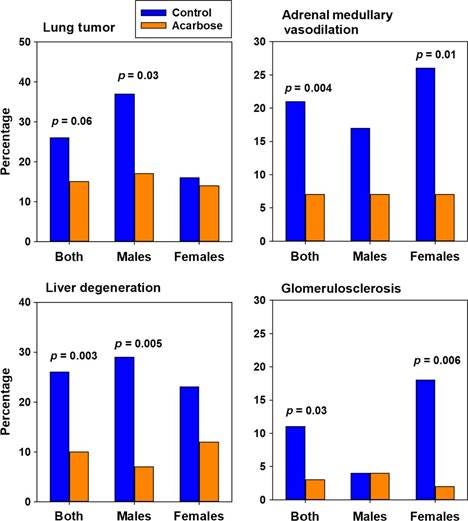

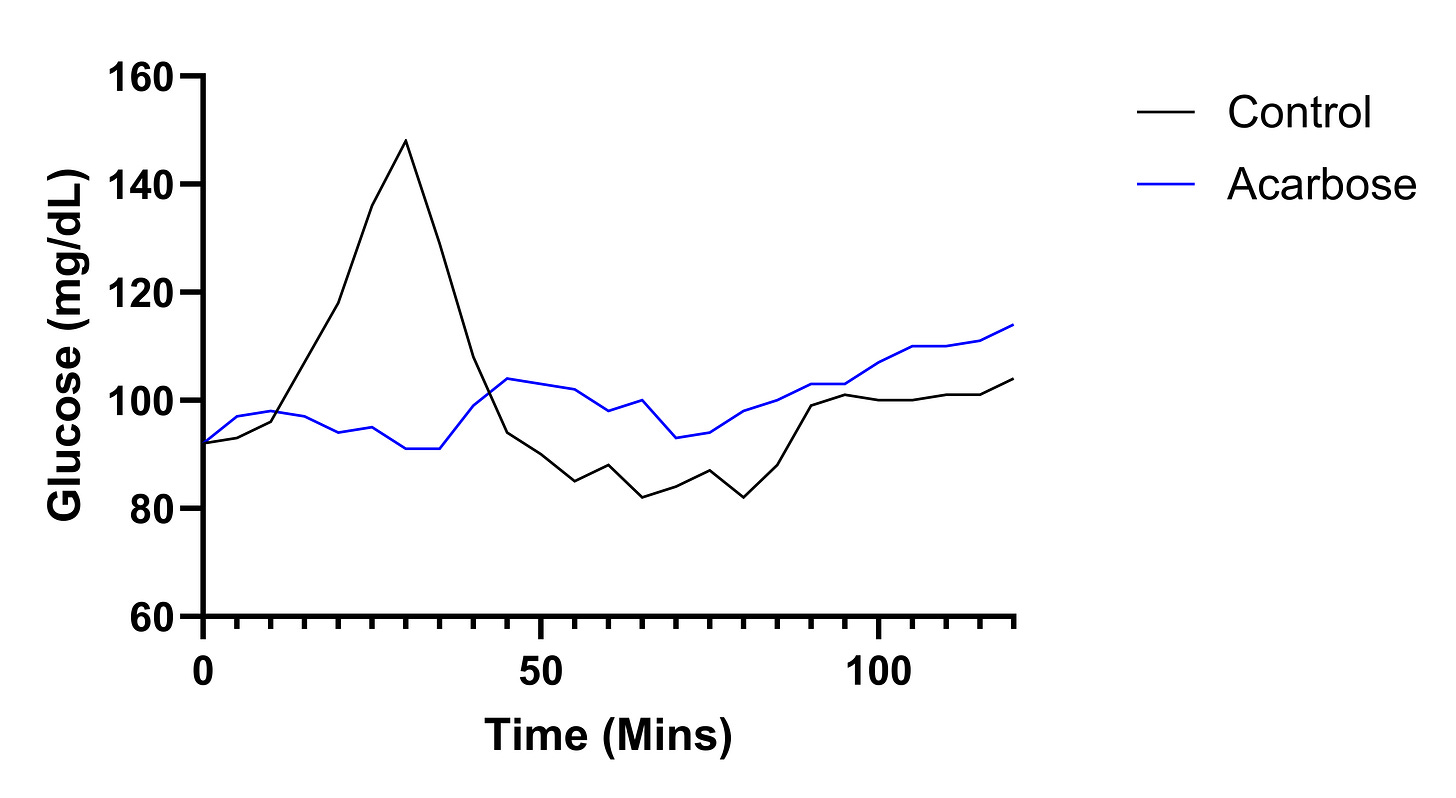
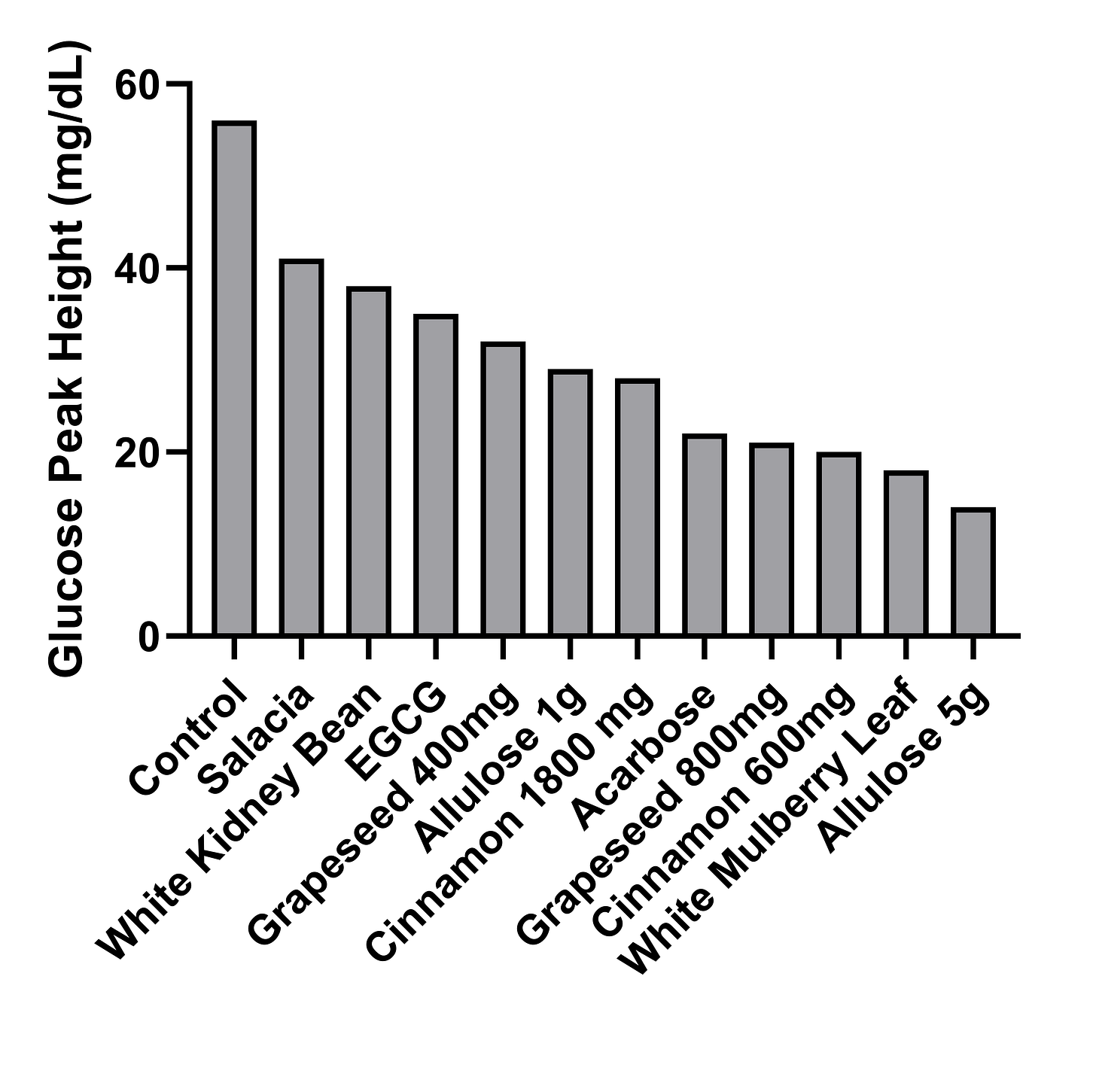
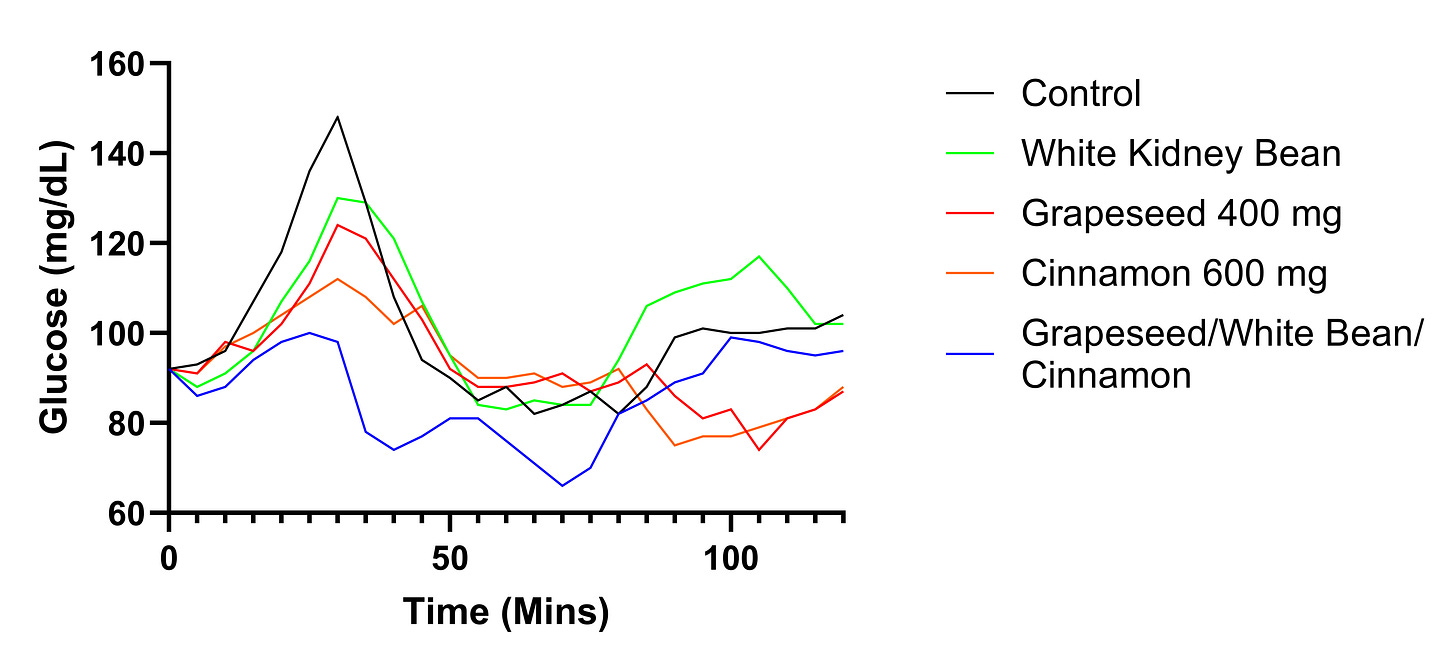
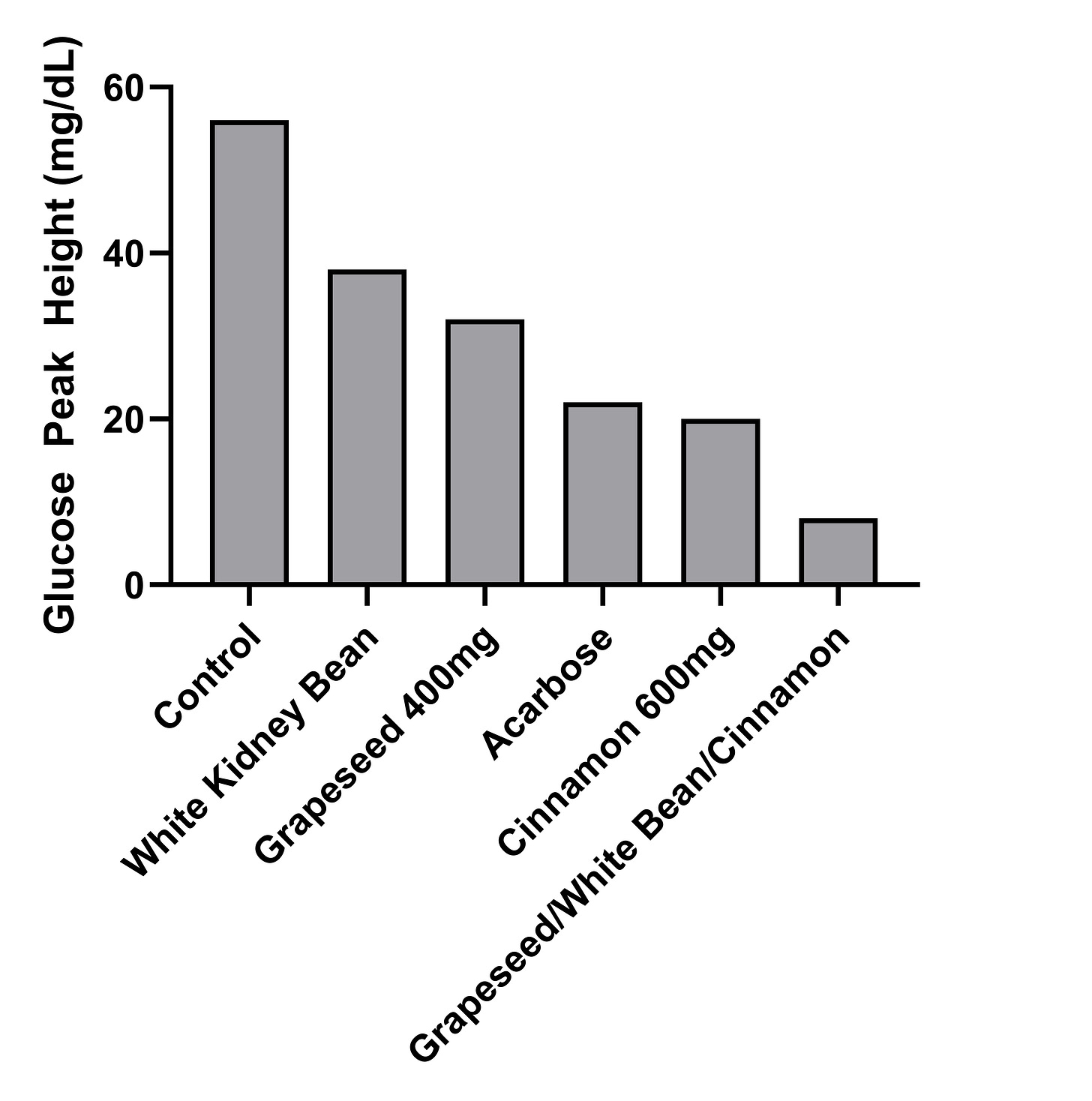
I can across this on RapaNews and tried it out tonight. Worked really well. I usually take 50-100 mg acarbose with meals, but tried this cocktail instead. I even had some cake bc it was my wife's birthday. Greatly blunted the glucose increase. Thank you for posting this!!
Have you tried acarbose with fruit (especially apples vs stone fruits vs tropical fruits)? Stone and Tropical fruits have more sugars in the form of disaccharides... Have you figured out how to reduce the glucose spike from fruit high in monosaccharide sugars?